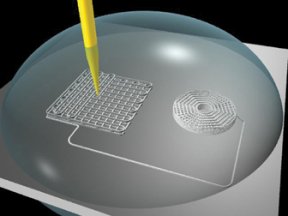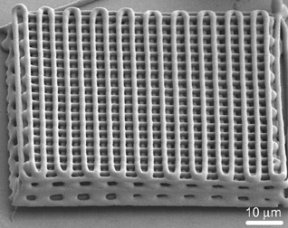- More than 2 years ago
A printing technique emulating the way spiders spin silk generates polymer microstructures a hundredth the size of those produced by existing three-dimensional printing technologies. The new fabrication scheme could prove to be a cheaper and more flexible route to building miniature constructions, including scaffolds for growing replacement tissues and photonic crystals for optical computing.


Using a printer to create 3-D structures layer by layer isn’t new. Designers have done it for years in the production of prototype machine parts. However, printing structures with features on the scale of microns or smaller has been a challenge.
Researchers have used light to etch such features onto polymer wafers, but that approach is costly and can’t build 3-D structures.
The new technique, developed by Jennifer Lewis and her colleagues at the University of Illinois at Urbana-Champaign, overcomes those barriers. For inspiration, the Illinois team examined how spiders spin microfibers of silk.
Spinneret organs on the animals’ abdomens extrude a solution of proteins that solidify as silk outside the spider.
The researchers designed a new kind of ink consisting of one negatively charged polymer and one positively charged polymer. In spiderlike fashion, a syringe loaded with the liquid polymers squirts out thin streams of the mixture.
To form filaments, however, the syringe must extrude the ink into a liquid reservoir—in particular, a dime-size drop of alcohol and water on a glass slide—rather than onto a dry surface. Because the ink is insoluble in the reservoir, the oppositely charged polymers bind to each other, causing the ink to coagulate.
A robotic arm moves the syringe across the glass surface, depositing sequential layers of filaments in a specified pattern within the alcohol drop, ultimately generating a 3-D structure.
By varying the width of the syringe’s nozzle, the researchers can control the diameter of the polymer filaments. In the March 25 Nature, the researchers report that they’ve printed filaments 1 micron in diameter. Team member Gregory Gratson says his lab has since fabricated even smaller filaments, measuring only 0.5 micron, or 500 nanometers, wide. A typical strand of hair spans about 75 microns.
“What I like about this technique is its incredible simplicity,” says applied physicist David Weitz of Harvard University. Researchers can program the printing system to build any kind of structure. For instance, the Illinois scientists say they might be able to print biodegradable and biocompatible scaffolds for growing new tissues for surgical procedures.
Right now, the team is using the printer to make photonic crystals, which can manipulate light on a small scale and potentially serve as optical computer chips or lasers. The idea is to print 3-D polymer structures and use them as molds.
Filling in the mold’s pores with silicon or selenium and then removing the
polymer will yield a photonic crystal, says Gratson.





